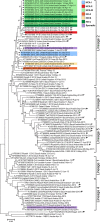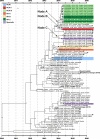Zoonotic origin and transmission of Middle East respiratory syndrome coronavirus in the UAE
- PMID: 29239118
- PMCID: PMC5893383
- DOI: 10.1111/zph.12435
Zoonotic origin and transmission of Middle East respiratory syndrome coronavirus in the UAE
Abstract
Since the emergence of Middle East respiratory syndrome coronavirus (MERS-CoV) in 2012, there have been a number of clusters of human-to-human transmission. These cases of human-to-human transmission involve close contact and have occurred primarily in healthcare settings, and they are suspected to result from repeated zoonotic introductions. In this study, we sequenced whole MERS-CoV genomes directly from respiratory samples collected from 23 confirmed MERS cases in the United Arab Emirates (UAE). These samples included cases from three nosocomial and three household clusters. The sequences were analysed for changes and relatedness with regard to the collected epidemiological data and other available MERS-CoV genomic data. Sequence analysis supports the epidemiological data within the clusters, and further, suggests that these clusters emerged independently. To understand how and when these clusters emerged, respiratory samples were taken from dromedary camels, a known host of MERS-CoV, in the same geographic regions as the human clusters. Middle East respiratory syndrome coronavirus genomes from six virus-positive animals were sequenced, and these genomes were nearly identical to those found in human patients from corresponding regions. These data demonstrate a genetic link for each of these clusters to a camel and support the hypothesis that human MERS-CoV diversity results from multiple zoonotic introductions.
Keywords: dromedary camel; epidemiology; genomics; middle east respiratory syndrome; viral pathogens; zoonoses.
© 2017 The Authors. Zoonoses and Public Health Published by Blackwell Verlag GmbH.
Conflict of interest statement
The authors declare no conflict of interests.
Figures





References
-
- Adney, D. R. , van Doremalen, N. , Brown, V. R. , Bushmaker, T. , Scott, D. , de Wit, E. , … Munster, V. J. (2014). Replication and shedding of MERS‐CoV in upper respiratory tract of inoculated dromedary camels. Emerging Infectious Diseases, 20(12), 1999–2005. 10.3201/eid2012.141280 - DOI - PMC - PubMed
-
- Al Hammadi, Z. M. , Chu, D. K. , Eltahir, Y. M. , Al Hosani, F. , Al Mulla, M. , Tarnini, W. , … Poon, L. L. (2015). Asymptomatic MERS‐CoV infection in humans possibly linked to infected dromedaries imported from Oman to United Arab Emirates, May 2015. Emerging Infectious Diseases, 21(12), 2197–2200. 10.3201/eid2112.151132 - DOI - PMC - PubMed
-
- Al Hosani, F. I. , Pringle, K. , Al Mulla, M. , Kim, L. , Pham, H. , Alami, N. N. , … Gerber, S. I. (2016). Response to emergence of Middle East respiratory syndrome coronavirus, Abu Dhabi, United Arab Emirates, 2013‐2014. Emerging Infectious Diseases, 22(7), 1162–1168. 10.3201/eid2207.160040 - DOI - PMC - PubMed
MeSH terms
Associated data
- Actions
- Actions
- Actions
- Actions
- Actions
- Actions
- Actions
- Actions
- Actions
- Actions
- Actions
- Actions
- Actions
- Actions
- Actions
- Actions
- Actions
- Actions
- Actions
- Actions
- Actions
- Actions
- Actions
- Actions
- Actions
- Actions
- Actions
- Actions
- Actions
- Actions
- Actions
- Actions
- Actions
- Actions
Grants and funding
LinkOut - more resources
Full Text Sources
Other Literature Sources
Medical

